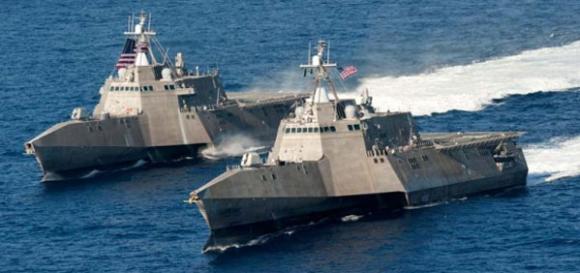 “The experience of LCS, it broke the Navy,” said Sean Stackley, Assistant Secretary of the Navy for research, development and acquisition.
“The experience of LCS, it broke the Navy,” said Sean Stackley, Assistant Secretary of the Navy for research, development and acquisition.
The Navy’s ambitious Littoral Combat Ship (LCS) program promised low cost, highly flexible, reliable, multi-mission ships. So far they have delivered none of these. Last Thursday, a panel of Navy and government oversight officials told the Senate Armed Services Committee about billions in cost overruns, delayed deliveries, repeated breakdowns, reduced mission capabilities and the questionable survivability of the new LCS.
LCS costs have risen from an estimated $220 million per ship to an average of $478 million. In a Government Accountability Office (GAO) report issued on Thursday which reviewed the $29 billion LCS program, the GAO says that Congress must decide “whether a ship that costs twice as much yet delivers less capability than planned warrants an additional investment.” The GAO also expressed concern about the Navy’s plans for 12 redesigned littoral combat ships, to be called frigates, which will put taxpayers on the hook for nearly $14 billion.
The GAO report also notes: Concerned about the LCS’s survivability and lethality, in 2014 the Secretary of Defense directed the Navy to evaluate alternatives. After rejecting more capable ships based partly on cost, schedule, and industrial base considerations, the Navy chose the existing LCS designs with minor modifications and re-designated the ship as a frigate. Much of the LCS’s capabilities are yet to be demonstrated and the frigate’s design, cost, and capabilities are not well-defined. The Navy proposes to commit quickly to the frigate in what it calls a block buy of 12 ships.
In addition to being late and more expensive, the LCS have been notoriously unreliable. Michael Gilmore, the Pentagon’s Director of Operational Test And Evaluation has said that the current fleet of eight ships “have a near-zero chance of completing a 30-day mission,” the Navy’s requirement, without a critical failure of one or more seaframe subsystems essential for wartime operations. The ships also do not meet the Navy’s standards for survivability.
Paul L. Francis, managing director of Acquisition and Sourcing Management for the GAO, said, “The bottom line on the LCS is we’re 26 ships into the contract and we still don’t know if the LCS can do its job. Over the last 10 years, we’ve made a number of trade-downs. We’ve accepted higher cost, construction delays, mission module delays, testing delays, reliability and quality problems, and lower capability. To accommodate the lesser performance of the ship, we’ve accepted a number of work-arounds: higher crew loads, more shore support, … reduced mission expectations for the ship. It will be 2020 before we know that the ship and all of its mission modules will work.”
“The miracle of LCS didn’t happen,” Francis told the Senate panel.

With numbers like that why wait to end the LCS’s NOW! No need to keep throwing good money on systems that keep failing. The idea has promise yet the ships of world war 2 are still around and floating. Yet I question things like using aluminum that does not have battle survivability over steel, especially when a hull develops cracks in warm weather and calm waters of the Panama Canal. Hopefully President Trump will give the program the swift kick it needs.
Dump these pieces of junk. Ensure that their bad performance is reflected in the evaluations of the officers and civilians responsible for the program. Instruct the Navy to immediately cease using older serviceable ships like the Spruances as targets for live fire exercises. Ensure that modernization and upgrading of the Arleigh Burkes continues.
One remembers a discussion about the Zumwalt’s gun being a non-fireable model. My comment to that post was pooh-poohed therefore my comment here is reserved. The USN is a mess with ships not working and several officers losing commands. One must therefore agree with William Nicholson’s comment. Hopefully that will happen with the next Administration because it certainly will not come about in this Administration.
Good Watch.
The first LCS came was commissioned in 2006, years before the current president assumed office. In fact, Senator McCain complained about the program during the 2008 presidential debates. The ship was the product of the Bush administration and in particular Donald “Transformational” Rumsfeld’s belief that everything could be done on the cheap and with fewer people. Laying the blame for the LCS concept on this administration is ridiculous.
What is this !! My comment should be read accurately Mr. Paine as at no time did one “blame” this Administration for the LCS program. Well Senator McCain complains about so many things it is hard to keep track but I do of course agree with you that these vessels are a product of the Bush/Rumsfeld days the latter drowned us all in “snowflakes”. This Administration will not get involved with correcting the LCS situation leaving it to the next Administration – which was my point.
Good Watch.
It is a little misleading to say that the LCS did not meet the Navy standards for reliability because it didn’t get tested at full shock load when it was the Navy that decided not to test it at full shock. Why run the test then if you think that if the ship passes it doesn’t matter? Also the LCS consists of two completely different ships (and two completely different manufacturers) and though the one that gets pictures often in the tri-hull design most of the failures listed are for the flat hull design. By mixing and matching failures from the two ships it makes the list look far larger than warranted.
Both classes of ship have been notoriously unreliable.
So they decided to bill retirees for health care to help supplement the failure.